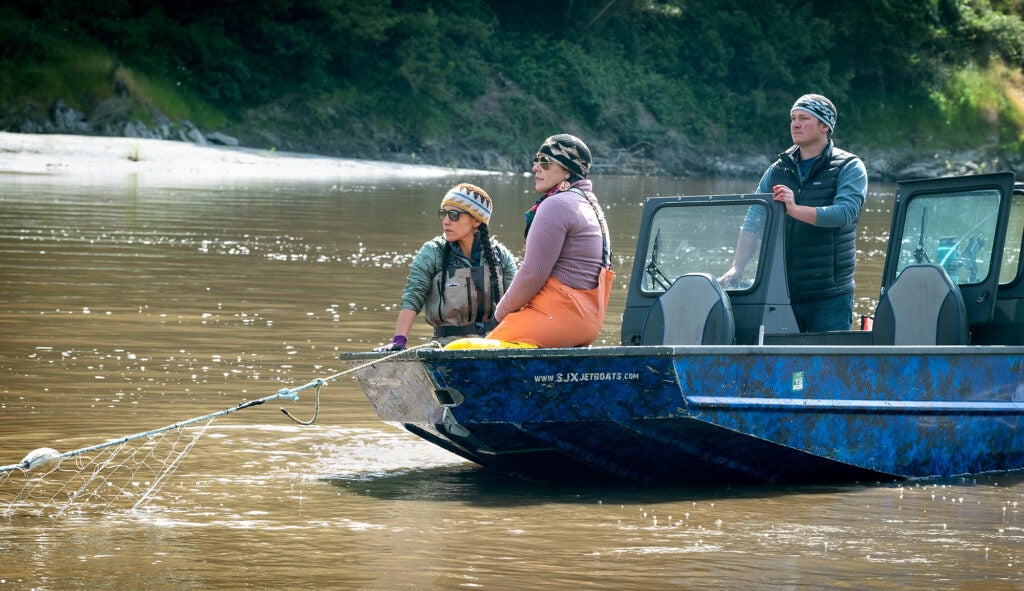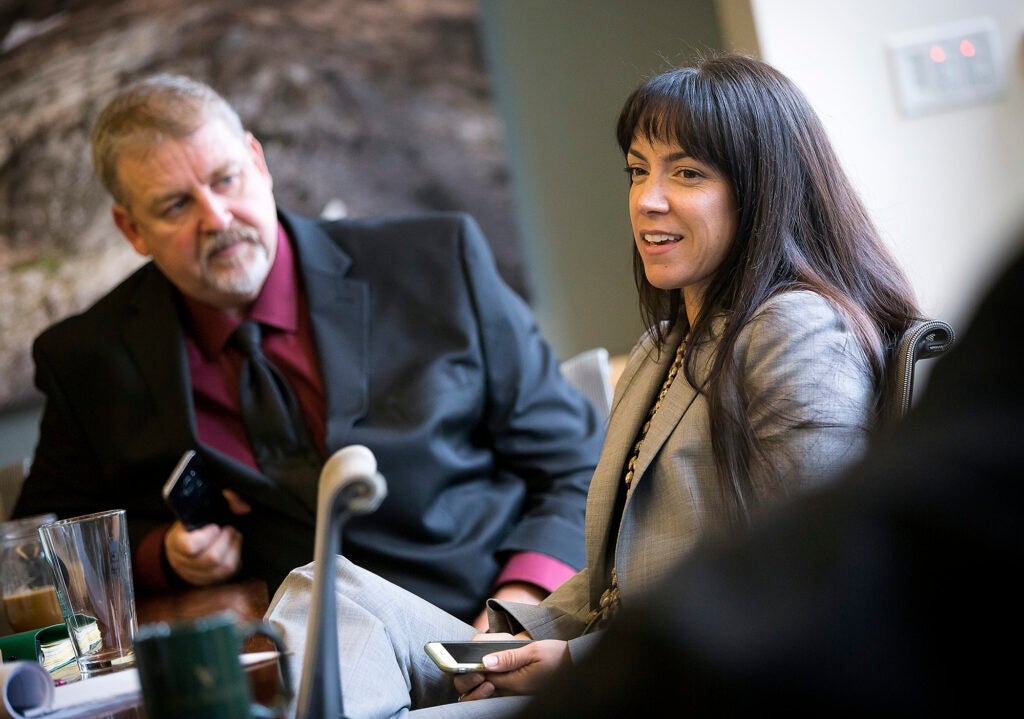Klamath River Dam Removal Is a Victory for Tribes
After a century of ecological collapse, steelhead and salmon in the Klamath River now have a fighting chance at a full recovery.

This page was published a year ago. Find the latest on Earthjustice’s work.
This year, engineers in California and Oregon are carrying out the largest dam removal project in history.
For decades, salmon and trout in the Klamath River have struggled to survive in the unhealthy water conditions created by four dams and diversions of water for irrigation. And for more than 20 years, Indigenous Tribes that depend on the fish have been fighting for dam removal. In late 2022, after many rounds of litigation to keep water flowing and the fish alive, federal regulators finally approved a dam removal plan.
As the dams on the Klamath come down, members of the Yurok, a Tribe whose reservation sits at the mouth of the river, say they are feeling hopeful about the Klamath’s future. On its own, freeing the Klamath from these massive installations will not restore healthy salmon and trout populations, improve water quality, or ensure that the tribes’ federally reserved water rights will be protected – but it is a transformational first step toward doing so. It is also galvanizing momentum for dam breaching and ecological restoration on other rivers, including the Snake River in the Pacific Northwest.

Amy Cordalis, Ashley Bowers and William Bowers fish on the Klamath River. (Swiftwater Films)
Ashley Bowers smiles when she thinks about her childhood fishing trips with her family along the Klamath River.
“In those days, it was normal to catch upwards of 300 fish in one day,” recalls Bowers, a Yurok Tribal member. “The salmon were plentiful, and the river was teeming with life.”
Today, almost three decades later, it’s a lucky day if she catches four or five fish. Once home to the nation’s largest fall and spring salmon runs, the Klamath is now a shell of its former self.
Throughout the 20th century, a massive buildout of canals and pumping stations known as the Klamath Irrigation Project overtook the river, which flows from the high desert in southern Oregon through northern California to the Pacific Ocean. The region’s arid climate prevents many crops from growing naturally, so commercial farming operations have used this irrigation network to divert enormous amounts of water from the river for large-scale agriculture.
Adding to the stress on the river from water diversions, the Lower Klamath Project, four hydroelectric dams owned by the private company PacifiCorp prevented salmon and steelhead trout from accessing hundreds of miles of upstream spawning grounds, decimating the river’s once-abundant populations of salmon and steelhead trout.
Klamath Basin tribes that rely on those fish – the Yurok, Karuk, Hoopa, and others – have endured a century-long battle for survival ever since the first canal was installed in the river. By 1964, the four lower Klamath dams had been constructed. And by the 1980s, the fish sacred to the Klamath Tribes had become so scarce in Upper Klamath Lake that they were listed as endangered. Salmon in the Klamath River were protected under the Endangered Species Act in 1997 due to their precipitous decline.

Members of the Yurok Tribe fish for salmon in the Klamath River. (Martin do Nascimento / Earthjustice)
In 2001, a drought further depleted river levels and worsened the region’s already dire water scarcity crisis. Earthjustice helped tribes and commercial fishers pursue a lawsuit to compel the federal government to reduce the amount of water diverted to irrigate crops.
By the next spring, the government had adopted a new plan prioritizing water for irrigation over salmon. The crisis for salmon reached a tipping point by the end of the summer.
More than 60,000 dead adult Chinook salmon floated to the surface of the lower Klamath over eight days in September 2002, sparking widespread despair, anger, and an urgent call to action.
“Never in our time have we […] seen such a mass destruction of our salmon resource,” Yurok elders stated in the weeks following.
The catastrophe launched a groundswell of scrutiny that brought together tribal members, officials from California and Oregon, and conservation groups.
“The fish kill was a wake-up call. It became clear that the river would not survive, and thus the Yurok would not survive, if it continued to be mismanaged this way,” says Amy Cordalis, a Yurok tribal member and attorney who previously served as the Tribe’s general counsel.

Amy Cordalis talks with coalition partners at a legal meeting at Earthjustice headquarters in San Francisco in 2018. (Martin do Nascimento / Earthjustice)
While the fish kill ignited a surge of public awareness and momentum around the plight of the river, the dams still had entrenched political backing from electric utilities and farmers. Despite the tribes’ deep cultural and economic ties to the river, they were at first rarely offered a seat at the stakeholders’ table, which forced them to get creative in their advocacy.
“We had incredibly smart folks who knew how to play the political game from the inside and outside,” says Cordalis.
To capture the ear of key decision-makers, tribal leaders united with allies across the U.S. and beyond its borders. In 2004, vice chairmen from the Yurok and Karuk tribes joined a group of over two dozen activists who traveled to Scotland to demonstrate in front of the annual stockholders meeting of Scottish Power, the parent company of PacifiCorp.
Later that year, another strategic opportunity opened up: After 53 years, PacifiCorp’s license to operate the dams was expiring. The company had recently applied for renewal to the Federal Energy Regulatory Commission (FERC), and FERC would need to determine whether reissuing the license was in the public’s interest.
The tribes underscored to the FERC commissioners how grave a threat the dams posed to their food and water supply, livelihood, and cultural heritage. They argued that there were only two legal paths forward: Either PacifiCorp could implement significant, expensive updates to the dams to ensure salmon had access to their full spawning grounds and habitat, or the dams must come down.

Members of the Karuk and Hoopa Tribes protest outside Scottish Power’s annual general meeting at Edinburgh’s Festival Theatre in 2004. (Maurice McDonald / PA Images via Getty Images)
Negotiations between the government, tribes, farmers, and ranchers continued for several years, as reality set in that the river could no longer sustain every party’s needs.
In 2016, Cordalis assumed her role as general counsel for the Yurok Tribe. Among her first orders of business was partnering with Earthjustice attorney Patti Goldman to file another lawsuit that successfully allocated more water to reduce disease mortalities in the river’s coho salmon. Earthjustice represented the Tribe in six such lawsuits, buying the fish time while the dam removal negotiations played out.
“Patti is one of the best litigators I’ve ever seen in action,” Cordalis notes. “I’ve learned so much working with her.”
Meanwhile, efforts to remove the dams were picking up steam. In 2016, PacifiCorp opted out of renewing the license and got behind dam removal, recognizing it would be more affordable than making the necessary upgrades. It took nearly eight more years to develop the dam removal plan, conduct environmental and safety reviews, and navigate around political backlash from some quarters.
Your support helps us fight for endangered species — and win.
The historic decision to honor tribal rights by removing the Klamath dams could reverberate far beyond northern California. Pacific Northwest tribes that have spent decades fighting to free the lower Snake River from its own set of salmon-killing dams are also now seeing a road open toward recovery. In December 2023, a coalition of Columbia Basin tribes, fishers, and clean energy groups represented by Earthjustice joined with the Biden administration to announce a groundbreaking new initiative that sets a path to breach the Snake River dams.
It will take a while for the Klamath River to begin to flow more naturally. But in the five months since the first dam was removed, Cordalis has noticed signs of recovery. Water clarity is already beginning to improve.
“What I want people to take away from this decades-long fight is to have hope, and to understand that we don’t have to accept the status quo of environmental collapse – we can choose a different outcome,” she says. “It will be hard, but it is worth it.”
Established in 1987, Earthjustice's Northwest Regional Office has been at the forefront of many of the most significant legal decisions safeguarding the Pacific Northwest’s imperiled species, ancient forests, and waterways.